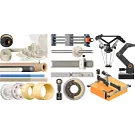Reckmann Yacht Equipment GmbH specialises in the development and production of furling systems that reduce the sail area in very strong winds. The company has made a name for itself in the top segment of sailing with its manual, electric and hydraulic reefing systems. It also implements particularly powerful systems for ships up to 66 metres in length, which can reef sails up to 90 metres long.
To ensure that the reefing system works in every situation, the careful design of the reefing systems takes centre stage. This is particularly evident in the top swivel, which sits at the top end of a reefing system and holds the sail. When the sailor furls the sail, the inner part of the top swivel must move synchronously - as smoothly as possible and without any stick-slip effect. This places high demands on the bearing and the entire design of the component. In addition, salt water and the tropical climate, which are very hard on the components, pose particular challenges for the designer.
Most important, however, are the enormous mechanical loads that act on the bearing points: Large ocean-going yachts and circumnavigators have headsails with a surface area of 1,000 m2 or more. To furl this surface area, drive torques of up to 5,500 Nm must be applied. The high forces require drives consisting of extremely compact hydraulic motors with an operating pressure of 175 bar. And a current development that Reckmann is driving forward places even higher demands on the drives of the furling systems: instead of the usual profiles in which the sails are attached, carbon stays are used that are pre-tensioned to up to 65 tonnes. Under these conditions, the drives and top swivels must ensure that the sails can be furled and unfurled without any problems at all times.
The high demands on the load capacity and availability of the drive components mean that Reckmann develops and manufactures many components in-house - even the ball bearings. The bearings rotate under load and have to absorb very high axial and radial forces. Originally, one roller bearing each was used to absorb the axial and radial forces.




